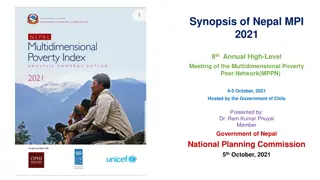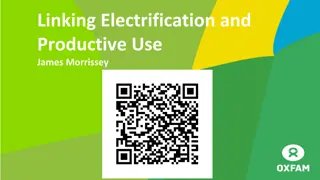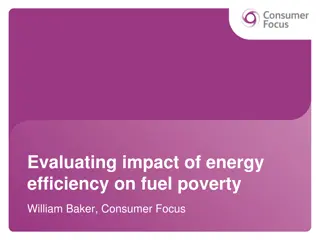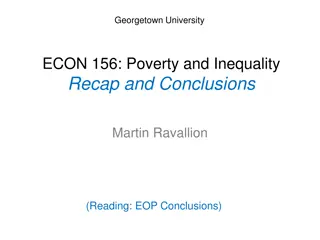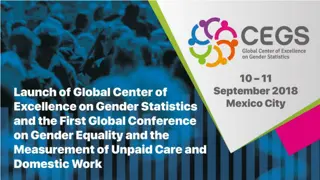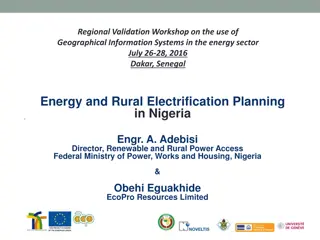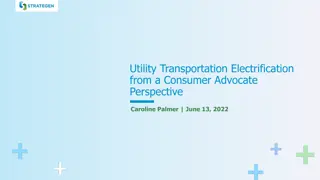Understanding Poverty and Social Impacts of National Electrification Program
Studying poverty and social impacts in the context of the National Electrification Program is crucial for identifying barriers to electricity access, understanding community perspectives, and ensuring inclusivity. Key observations highlight the challenges faced by poor households, emphasizing the need for targeted subsidies and support. The cost of connecting to the grid, especially for rural and poor households, presents significant barriers that require strategic interventions and community involvement.
Download Presentation

Please find below an Image/Link to download the presentation.
The content on the website is provided AS IS for your information and personal use only. It may not be sold, licensed, or shared on other websites without obtaining consent from the author. Download presentation by click this link. If you encounter any issues during the download, it is possible that the publisher has removed the file from their server.
E N D
Presentation Transcript
Poverty & Social Impacts of the NEP Removing barriers to electricity access
Why Study Poverty and Social Impacts? Better understand institutions and roles in electrification process Study Aims: Identify use patterns and barriers to access Understand to local community perspectives and involvement Protect poor and vulnerable at risk of exclusion Ensure consumers are informed of their options and allow opportunity for feedback to improve service Critical Project Needs: Balance financial sustainability with consumer concerns over quality and affordability In 2014-2015 interviews and surveys of 24 villages, 16 wards engaging leaders, VECs, women, livelihood groups, SMEs, govt agencies Data obtained: Data from 2009/2010 living standards survey
Key Observations Up-front costs significant inhibiting factor for poor and middle income HHs Grid-connected households pay less monthly than non-grid (diesel, battery) Unreliable grid supplies lead to additional burdens (use of back-up diesel) Service quality: Increases in tariffs and responsive service go hand in hand Self Reliant Electrification can be enhanced with support for poor households Village Electrification Committee can be a force for inclusive participation Key Recommendations Expanded community consultations and information disclosure Monitoring and evaluation to assess effectiveness / identify those in need of support Targeted subsidization for poor and vulnerable households
The Cost of Getting Connected 77% urban HH and 10 % rural HH grid connected, high variability for the rest (diesel gen set, candle only, batteries, solar pv). Variable connectivity High up-front costs for rural households Rural HHs have more income availability during harvest season, livestock sales Seasonal Ability Rural/poor HH connection fees are on average higher than wealthy HH Poor pay more Poorest cannot pay Poorest could not afford to pay for minimal lighting (use candles)
Connection Charges and National Electrification Rates Myanmar Average Connection Charges POOR 250,000 URBAN MIDDLE 190,000 Households Surveyed WEALTHY 225,000 POOR 420,000 RURAL MIDDLE 440,000 WEALTHY 230,000 0 100,000 200,000 300,000 400,000 500,000 Average fee paid for connection for Govt Grid Golumbeanu & Barnes 2013:7 World Bank
Impact of Tariff Increases Existing users very little electricity (below 100 kwh lifeline) and new users already pay more on private sources Low impact on poor Quality, reliability, affects on high urban use (middle and high income, SMEs), costs more for back-up during blackouts Tariff Concerns Example: service quality improvement in Mandalay Regional DESE partnered with private companies since 2012 HHs noticed replacement of old analogue with new digital meters, Less blackouts, voltage variation, improved capacity Reduce concern about increases by demonstrating improved service Public-Private New equipment and reliability: Reaction to tariff increases Demonstrated in use of more expensive private suppliers when grid unavailable Willingness to pay Average 2.2% of HH expenditure (Grid only 1.4%) Fluctuating diesel prices impacting SME productivity. 40w TV costs 3,000 Kyats for 3 hrs on diesel Gen Set but only 126 kyats at 35 kyat/kwh for 3 hrs (plus ability to use for 10-12 hours) Private Suppliers more expensive, less reliable
Self-Reliant Electrification SRE process Information requested: Village leadership approaches Township Electricity Department Village Electrification Committee (VEC) formed: members selected, proposal developed Proposal Review: Township ED and Regional DESE: Review proposals, designs and cost estimates Readiness to connect: Township ED Inspects construction Construction: VEC follows 12- point guide to engage with utility provider for construction Average time to electrification 3 years Influencing factors Limited oversight: Irregular inspection leading to poor quality construction, delays, inability to cover repairs Discretionary funding: Support from benefactors, high-interest loans, sale of assets to cover costs Variable tariffs: Differ from government rates, some maintenance fees, collection fees VEC Interpersonal networks: Levels of information provision, support dependent on leadership networks participation: Variable VEC selection process, unclear member roles, lack of public consultation Key risks it was a huge investment for us. Electricity is much more expensive than a pair of oxen. Until now, some cannot buy their cattle back, some were never able to get their farmlands back, and some are still badly in debt. Our village hasn t yet recovered from the electricity shock . Poverty was the price for electricity. (elder farmer quoted p. 30 PSIA 2015) Indebtedness: HHs sell cattle, farmland and borrow at high interest rates impacting on livelihoods Delays and frustration: due to poor planning, unexpected costs (meter installment, repairs etc) Limited access or system shutdown: Only wealthy villages / HH can connect, system financially unviable
Village Electrification Committees (VECs) in practice Compile HH lists, arrange pool of funds, supervise construction, collect fees, communicate with Township and with participating households Key focal point: Good Practice Observed Governance: election and periodic rotation of membership Representation: of different ethnic groups present in the village Responsive: regular meetings to receive, address community questions and concerns Transparency: accounts audited, clear billing and explanation of charges Support: Township electricity dept training villages in operation and maintenance Challenges Observed Risk of exclusion from access Elite membership with limited mobilization: only two cases of election and one case of regular village-wide meetings surveyed, varying bills and tariffs No participation of poor households: early decision made by VEC to only include those who could afford connections Formal participation of women: considered ineligible due to domestic responsibilities despite these including provision of energy for obtaining domestic use (firewood, charcoal) No subsidization: cross-subsidization (wealthy HH paying more) or payment installment options (credit and long-term payment periods for poor HH) Representation of minorities: risk of inequality between the haves and have nots
Factors inhibiting social inclusion Lack of information and financial awareness, unclear bills, varying fees and charges The PSIA identifies impacts on consumer participation Exclusion of women from formal decision-making positions in VECs Lack of systematic guidance on household participation in electrification planning Few options for provision of feedback and response (phone no, TED pamphlets) Rural HH with limited labour (elderly dominated, youth out-migration, female headed) The PSIA identifies those most vulnerable and at risk of missing out Informal urban settlers without HH/land registration, landless farmers, day laborers Rural communities that cannot afford village grid connection Households in rural communities that cannot afford HH connection Communities uninformed about choices and actions required to access electrification
Technical assistance for social inclusion Key challenge for NEP target of universal coverage: Barriers for vulnerable (the poor, female-headed households, minorities) are not only financial but linked their awareness of options and participation in decision-making. Putting clear citizen engagement practice in place: Enhancing community involvement in electrification decisions through Village Electrification Committee formation, composition and decision-making structure and consultation process Disclosure and consultation (information dissemination and feedback meetings) Collaboration (membership in decision-making bodies, participatory planning and management) Grievance redress (formalized and functioning feedback mechanisms) Citizen-led monitoring and evaluation (satisfaction surveys) Identifying financial mechanisms for inclusion of the poor: Targeted subsidies for connections for disadvantaged households (eg. interest-free loan repaid alongside tariffs over 3 years) Eligibility criteria (eg. 1. permanent structure safe to electrify 2. poor = 6-month rice shortage, or no livestock, or no land title, delay period after first electrification effort) Establish criteria allowing informal settlers to apply for access in designated urban wards Tiered lifeline tariffs (instead of 35 kyt for 100 kwh, targeted tier to assist low consumption) Lessons from stakeholder consultation in Myanmar CDD project, subsidization eligibility in Lao PDR Power to the Poor Scheme
Closing the loop: monitoring and evaluation Provides feedback for improvement Evaluates effectiveness of the implementation process and approach Monitoring and evaluation Assesses effectiveness of consultations Reviews the grievance redress mechanism Tracks overall progress as well as for specific physical investments under the project Identifies benefits and impacts of electrification (income, education, health, productivity) Impact Identifies levels of electricity access including reliability and capacity of electricity service evaluation Assesses ability and willingness to pay for electricity Identifies who needs help (targeted subsidization) Develop program to assist those who need Help Information from M&E and impact evaluation will help us formulate policy and a specific program to help those who need it by providing a baseline to inform the terms of eligibility screening, outputs and outcomes
Further Information on the Poverty and Social Impacts Analysis 2015 Balance financial sustainability with consumer concerns over quality and affordability Critical issues: Protect poor and vulnerable at risk of exclusion Inform consumers of plans and options and allow opportunity for feedback Explain the institutions and roles involved in implementation of the NEP Study Aims: Identify barriers to accessing electricity in urban and rural areas Understand perceptions of affordability (connections, tariffs) and perspectives on quality Phase 1: February-June 2014, Phase 2: February-March 2015 24 rural villages and 16 urban wards involving well-off, middle income, poor households/wards Study Scope: Rural: Chin, Mandalay, Ayeyarwady, Kayin, Mon, Magway, Shan, Rakhine: community leaders, VECs, women, livelihood groups (agriculture, handicrafts) Urban: Yangon, Mandalay, Hakha, Sittwe, Thaton: township electricity departments, SMEs, industry as well as consultations with government agencies, private sector, CSOs 605 short household interviews (455 rural), 464 Key Informant Interviews (120 rural), 203 Focal Group Discussions (197 rural) Study Methods: Qualitative research into access barriers, demand, uses, perceptions of affordability and quality, coping strategies. Quantitative review of 2009/2010 Living Standards Survey (Myanmar Central Statistical) for consumption patterns, distributional impacts of new tariffs







